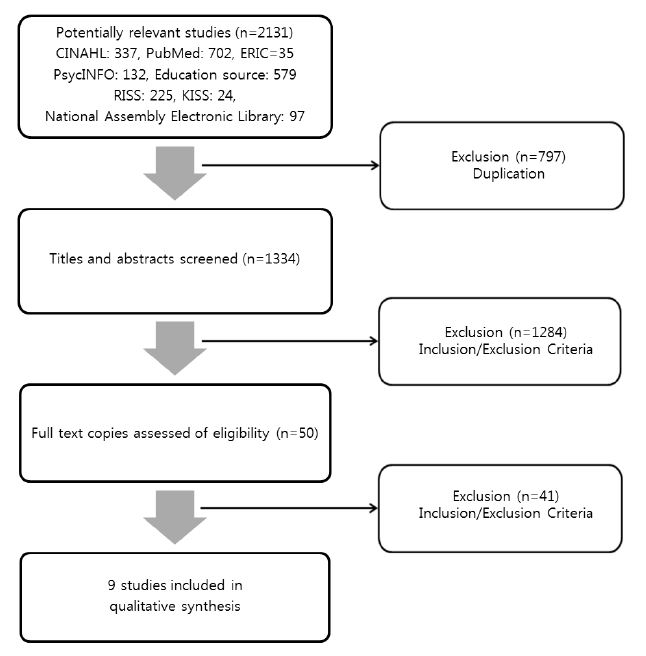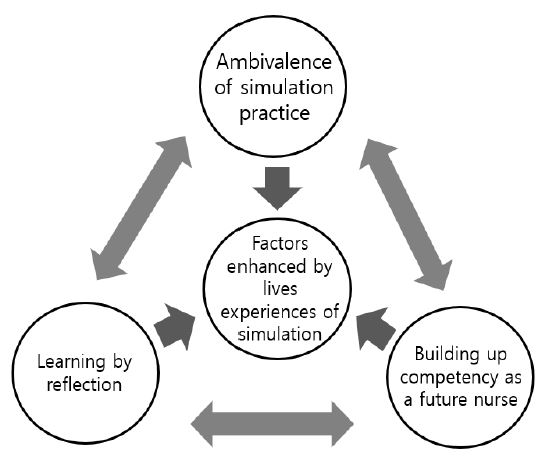Alexis, B. S., Robert, S., & Josef, T. (2018). The effectiveness of virtual simulation in improving student nurses' knowledge and performance during patient deterioration: A pre and post test design. Nurse Education Today, 62, 128-133. http://dx.doi.org/10.1016/j.nedt.2017.12.025
Alexis, B. S., Robert, S., et al, Josef, T.(2018The effectiveness of virtual simulation in improving student nurses' knowledge and performance during patient deterioration: A pre and post test design
Nurse Education Today62128-133
Bak, Y. G., & Kim, T. K. (2018). The effect of simulation-based education using a standardized patients for schizophrenia nursing care on communication self-efficacy, learning self-efficacy and flow experience in nursing students. Asia-pacific Journal of Multimedia Services Convergent with Art, Humanities, and Sociology, 8(6), 437-447. http://dx.doi.org/10.21742/AJMAHS.2018.06.64.
Bak, Y. G., et al, Kim, T. K.(2018The effect of simulation-based education using a standardized patients for schizophrenia nursing care on communication self-efficacy, learning self-efficacy and flow experience in nursing students
Asia-pacific Journal of Multimedia Services Convergent with Art, Humanities, and Sociology8(6437-447
Barker, A. B., Leighton, P., & Ferguson, M. A. (2017). Coping together with hearing loss: A qualitative meta-synthesis of the psychosocial experiences of people with hearing loss and their communication partners. International Journal of Audiology, 56(5), 297-305. http://dx.doi.org/10.1080/14992027.2017.1286695.
Barker, A. B., Leighton, P., et al, Ferguson, M. A.(2017Coping together with hearing loss: A qualitative meta-synthesis of the psychosocial experiences of people with hearing loss and their communication partners
International Journal of Audiology56(5297-305
Critical Appraisal Skills Programme. (2006). Qualitative research checklist. Retrieved from http://www.cfkr.dk/images/file/ CASP%20instrumentet.pdf
Jang, H. J., Kim, J. H., Ji, E. J., Jung, D. Y., Lee, S. H., Kim, S. H., et al. (2016). The study on current status of simulation based nursing education. Journal of Korean Society for Simulation in Nursing, 4(1), 1-12.
Jang, H. J., Kim, J. H., Ji, E. J., Jung, D. Y., Lee, S. H., Kim, S. H., et al(2016The study on current status of simulation based nursing education
Journal of Korean Society for Simulation in Nursing4(11-12
Jung, H. J. (2016). The development and effects of nursing simulation program based on the mastery learning model and peer feedback debriefing methods. Journal of Learner-Centered Curriculum and Instruction, 16(10), 29-57. http://dx.doi.org/10.22251/jlcci.2016.16.10.29.
Jung, H. J.(2016The development and effects of nursing simulation program based on the mastery learning model and peer feedback debriefing methods
Journal of Learner-Centered Curriculum and Instruction16(1029-57
Kaakinen, J., & Arwood, E. (2009). Systematic review of nursing simulation literature for use of learning theory. International Journal of Nursing Education Scholarship, 6(16), 1-20. http://dx.doi.org/10.2202/1548-923X.1688.
Kaakinen, J., et al, Arwood, E.(2009Systematic review of nursing simulation literature for use of learning theory
International Journal of Nursing Education Scholarship6(161-20
Kang, H. J., Kim, M. Y., & Choe, H. J. (2016). Effects of integrated nursing practicum by applying simulation-problem based learning on critical thinking disposition, nursing process competence, and self-confidence on core basic nursing skills. Journal of Learner-Centered Curriculum and Instruction, 16(12), 495-508. http://dx.doi.org/10.22251/jlcci.2016.16.12.495.
Kang, H. J., Kim, M. Y., et al, Choe, H. J.(2016Effects of integrated nursing practicum by applying simulation-problem based learning on critical thinking disposition, nursing process competence, and self-confidence on core basic nursing skills
Journal of Learner-Centered Curriculum and Instruction16(12495-508
Kang, H. Y., Choi, E. Y., & Kim, H. R. (2013). Nursing student’s experiences in team based simulation learning. The Journal of Korean Academic Society of Nursing Education, 19(1), 5-15. http://dx.doi.org/10.5977/jkasne.2013.19.1.5.
Kang, H. Y., Choi, E. Y., et al, Kim, H. R.(2013Nursing student’s experiences in team based simulation learning
The Journal of Korean Academic Society of Nursing Education19(15-15
Kim, C. S. (2012). Simulation-use learning experience of nursing students. Health Service Management Review, 6(3), 35-43. http://dx.doi.org/10.18014/hsmr.2012.6.3.35.
Kim, C. S.(2012Simulation-use learning experience of nursing students
Health Service Management Review6(335-43
Kim, E. J., & Kang, S. J. (2016). Effects of the simulation on the ego resiliency, self-efficacy and satisfaction of major of the nursing students. Journal of the Korea Academia-Industrial Cooperation Society, 17(1), 324-330. http://dx.doi.org/10.5762/kais.2016.17.1.324.
Kim, E. J., et al, Kang, S. J.(2016Effects of the simulation on the ego resiliency, self-efficacy and satisfaction of major of the nursing students
Journal of the Korea Academia-Industrial Cooperation Society17(1324-330
Kim, E. J., Kim, Y. J., & Moon, S. M. (2017). Nursing students' perceptions of meaning, response, and effective methods for debriefing in simulation-based education. Journal of Korean Academy of Fundamentals of Nursing, 24(1), 51-59. http://dx.doi.org/10.7739/jkafn.2017.24.1.51.
Kim, E. J., Kim, Y. J., et al, Moon, S. M.(2017Nursing students' perceptions of meaning, response, and effective methods for debriefing in simulation-based education
Journal of Korean Academy of Fundamentals of Nursing24(151-59
Kim, M. O., Lee, A. Y., & Nam, H. A. (2017). Effects on nursing students’ learning flow, critical judgement, and problem solving ability in simulation training: focused on obstetrical nursing case. Journal of Learner-Centered Curriculum and Instruction, 17(24), 521-534. http://dx.doi.org/10.22251/jlcci.2017.17.24.521.
Kim, M. O., Lee, A. Y., et al, Nam, H. A.(2017Effects on nursing students’ learning flow, critical judgement, and problem solving ability in simulation training: focused on obstetrical nursing case
Journal of Learner-Centered Curriculum and Instruction17(24521-534
Kim, M. Y., Park, S. H., & Won, J. S. (2016). Influence of nursing students’ anxiety during simulation training on personal satisfaction of simulation, self-efficacy, clinical competence. Journal of the Korean Academy of Fundamentals of Nursing, 23(4), 411-418. http://dx.doi.org/10.7739/jkafn.2016.23.4.411.
Kim, M. Y., Park, S. H., et al, Won, J. S.(2016Influence of nursing students’ anxiety during simulation training on personal satisfaction of simulation, self-efficacy, clinical competence
Journal of the Korean Academy of Fundamentals of Nursing23(4411-418
Kim, Y. G., Kim, J. S., Kim, H. R., Park, S. B., So, S. B., Jung, B. S., et al. (2017). Opinions and perceptions on allowing nursing students’ practice among inpatients at a university hospital. Perspectives in Nursing Science, 14(1), 10-20. https://dx.doi.org/10.16952/pns.2017.14.1.10.
Kim, Y. G., Kim, J. S., Kim, H. R., Park, S. B., So, S. B., Jung, B. S., et al(2017Opinions and perceptions on allowing nursing students’ practice among inpatients at a university hospital
Perspectives in Nursing Science14(110-20
Kim, Y. H., Hwang, K. L., & Cho, O. H. (2018). Simulation education with problem-based learning: Effect on nursing students' communication apprehension. Society for Personality Research, 46(1), 151-160. http://dx.doi.org/10.2224/sbp.6906.
Kim, Y. H., Hwang, K. L., et al, Cho, O. H.(2018Simulation education with problem-based learning: Effect on nursing students' communication apprehension
Society for Personality Research46(1151-160
Ko, S. J., & Choi, E. H. (2016). Effect of team debriefing in simulation-based cardiac arrest emergency nursing education. Korean Journal of Adult Nursing, 29(6), 667-676. http://dx.doi.org/10.7475/kjan.2017.29.6.667.
Ko, S. J., et al, Choi, E. H.(2016Effect of team debriefing in simulation-based cardiac arrest emergency nursing education
Korean Journal of Adult Nursing29(6667-676
Krueger, L., Emstmeyer, K., & Kirking, E. (2017). Impact of interprofessional simulation on nursing students' attitudes toward teamwork and collaboration. Journal of Nursing Education, 56(6), 321-327. http://dx.doi.org/10.3928/01484834-20170518-02.
Krueger, L., Emstmeyer, K., et al, Kirking, E.(2017Impact of interprofessional simulation on nursing students' attitudes toward teamwork and collaboration
Journal of Nursing Education56(6321-327
Kwak, E. M. (2017). Effects of simulation-based integrated nursing practice on nursing students. Asia-pacific Journal of Multimedia Services Convergent with Art, Humanities, and Sociology, 7(10), 445-455. http://dx.doi.org/10.14257/ajmahs.2017.10.77.
Kwak, E. M.(2017Effects of simulation-based integrated nursing practice on nursing students
Asia-pacific Journal of Multimedia Services Convergent with Art, Humanities, and Sociology7(10445-455
Merritt, L. S., Brauch, A. N., Bender, A. K., & Kochuk, D. (2018). Using a web-based e-visit simulation to educate nurse practitioner students. Journal of Nursing education, 57(5), 403-307. http://dx.doi.org/10.3928/01484834-20180420-10.
Merritt, L. S., Brauch, A. N., Bender, A. K., et al, Kochuk, D.(2018Using a web-based e-visit simulation to educate nurse practitioner students
Journal of Nursing education57(5403-307
Moher, D., Liverati, A., Tetzelaff, J., & Altman, D. G. (2009). Reprint-preferred reporting items for systematic reviews and meta-analysis: The PRISMA statement.
Physical Therapy, 89(9), 873-880. http://dx.doi.org/10.1093/ptj/89.9.873.

Moher, D., Liverati, A., Tetzelaff, J., et al, Altman, D. G.(2009Reprint-preferred reporting items for systematic reviews and meta-analysis: The PRISMA statement
Physical Therapy89(9873-880
Noblit, G. W., & Hare, R. D. (1988).
Meta-Ethnography: Synthesizing qualitative studies. Newbury Park: Sage.

Noblit, G. W., et al, Hare, R. D.(1988
Meta-Ethnography: Synthesizing qualitative studiesNewbury ParkSage
Oremann, M. H., Gagne, J. D., & Phillips, B. C. (2018).
Teaching in nursing and role of educator. NY: Springer Publishing Company.

Oremann, M. H., Gagne, J. D., et al, Phillips, B. C.(2018
Teaching in nursing and role of educatorNYSpringer Publishing Company
Park, Y. M. (2017). The effects of simulation-based practice on competence and satisfaction in nursing students. Journal of the Korea Academia-Industrial Cooperation Society, 7(6), 1-7. http://dx.doi.org/10.22156/CS4SMB.2017.7.6.001.
Park, Y. M.(2017The effects of simulation-based practice on competence and satisfaction in nursing students
Journal of the Korea Academia-Industrial Cooperation Society7(61-7
Sandelowski, M., Docherty, S., & Endem, C. (1997). Qualitative metasynthesis: Issues and techniques. Research in Nursing and Health, 20(4), 365-371. http://dx.doi.org/10.1002/(sici)1098-240x(199708)20:4<365::aid-nur9>3.0.co;2-e.
Sandelowski, M., Docherty, S., et al, Endem, C.(1997Qualitative metasynthesis: Issues and techniques
Research in Nursing and Health20(4365-371
Shearer, J. N. (2016). Anxiety, nursing students, and simulation: state of the science.
Journal of Nursing Education, 55(10), 551-554. http://dx.doi.org/10.3928/01484834-20160914-02.

Shearer, J. N.(2016Anxiety, nursing students, and simulation: state of the science
Journal of Nursing Education55(10551-554
Shim, K. K., Son, M. S., & Ji, E. S. (2017). The effectiveness of child nursing simulation using standardized patient on nursing student’s anxiety, self-efficacy and critical thinking disposition.
Journal of the Korea Academia-Industrial Cooperation Society, 18(10), 299-308. http://dx.doi.org/10.5762/KAIS.2017.18.10.299.

Shim, K. K., Son, M. S., et al, Ji, E. S.(2017The effectiveness of child nursing simulation using standardized patient on nursing student’s anxiety, self-efficacy and critical thinking disposition
Journal of the Korea Academia-Industrial Cooperation Society18(10299-308
Steropian, M., Brown, K., Gavilanes, J., & Driggers, B. (2004). An approach to simulation program evaluation.
Journal of Nursing Education, 3(4), 170-174.

Steropian, M., Brown, K., Gavilanes, J., et al, Driggers, B.(2004An approach to simulation program evaluation
Journal of Nursing Education3(4170-174
Yoon, J. H., & Lee, E. J. (2018). The effect of team based simulation learning using SBAR on critical thinking and communication clarity of nursing students.
Journal of the Korea Academia-Industrial Cooperation Society, 19(9), 42-29. http://dx.doi.org/10.5762/KAIS.2018.19.9.42.

Yoon, J. H., et al, Lee, E. J.(2018The effect of team based simulation learning using SBAR on critical thinking and communication clarity of nursing students
Journal of the Korea Academia-Industrial Cooperation Society19(942-29










